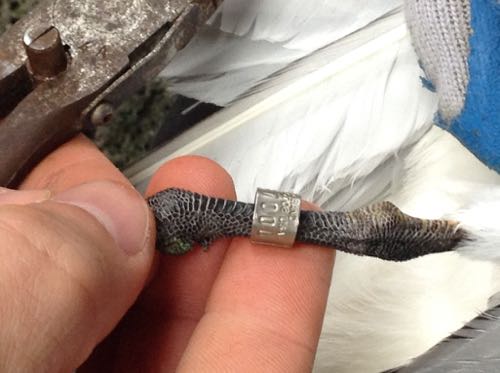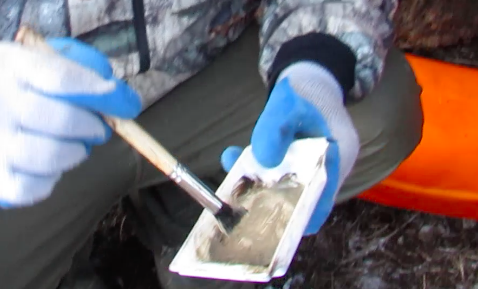A Day at the Bird Salon
 Some birds are calmer than others. This kittiwake seems content with its lot.
Some birds are calmer than others. This kittiwake seems content with its lot.
So, without feather ado... look no feather for info on the Bird Salon.
Remember the big rule? Move S L O W L Y, right?
Once the bird is captured, it's essential to move quickly, but in a way that doesn't further stress it out. Blood should be drawn within the first three minutes from the moment of capture, when someone yells "Catch!" and the timer is started. Sampling from the first three minutes provides the most accurate hormone assessment and helps decrease further inordinate stress.
Once blood is drawn, we measure the length of the wing and the tarsus (part of the leg). Measurements are also taken of the culmen (bill), and the headbill (distance from the back of the skull to the tip of the beak). The bird is also weighed.
 Measuring the wing feather.
Measuring the wing feather.
 Measuring the tarsus.
Measuring the tarsus.
 Measuring the culmen, which continues to grow, similar to a fingernail.
Measuring the culmen, which continues to grow, similar to a fingernail.
 Measuring from the notch on the back of the skull to the tip of the bill.
Measuring from the notch on the back of the skull to the tip of the bill.
 Birds are weighed in a bag using this scale.
Birds are weighed in a bag using this scale.
Some feathers are also gathered for analysis, and apparently they contain quite the bundle of clues based on molt cycles, pre- and post- breeding feathers, wing feathers, breast, back and head feathers. They comprise a pretty complete picture of contaminants, breeding clues, and even diet.
 All birds captured are banded.
All birds captured are banded.
Any food regurgitated is bagged (if it hasn't soaked into your clothes while holding it – yummy) and weighed, then sent off for further analysis, too.
 Collecting the regurge, including the ones on your pants, hands, and/or gloves.
Hair Dye
Collecting the regurge, including the ones on your pants, hands, and/or gloves.
Hair Dye
If a bird is caught and isn't part of the study, we don't want to disturb it again so a makeshift hair salon is established.
Why, you ask?
Hair dye is finessed onto the head and breast of the captured bird as a final step before release. The whole team will then know it's had its glamour appointment, and save us some time, preventing yet another capture. So there you have it. Field researchers have oodles of hidden talent.
 Mixing and prep on site, where the magic happens.
Mixing and prep on site, where the magic happens.
 Dye is placed on the head, then the breast so we can easily see it later.
Dye is placed on the head, then the breast so we can easily see it later.
 The birds seem calm when this happens... wonder if they like it?
The birds seem calm when this happens... wonder if they like it?
 Covering all the bases for dazzle.
Covering all the bases for dazzle.
My that bird look dazzling. All for the promise of not being disturbed again. Once again, beauty saves the day.
Today's Tweet
Field researchers have earned my respect. Hardworking, resourceful, and passionate, they do whatever it takes. #HairStylist #yearofthebird #BeautifulBirds


Comments
Add new comment